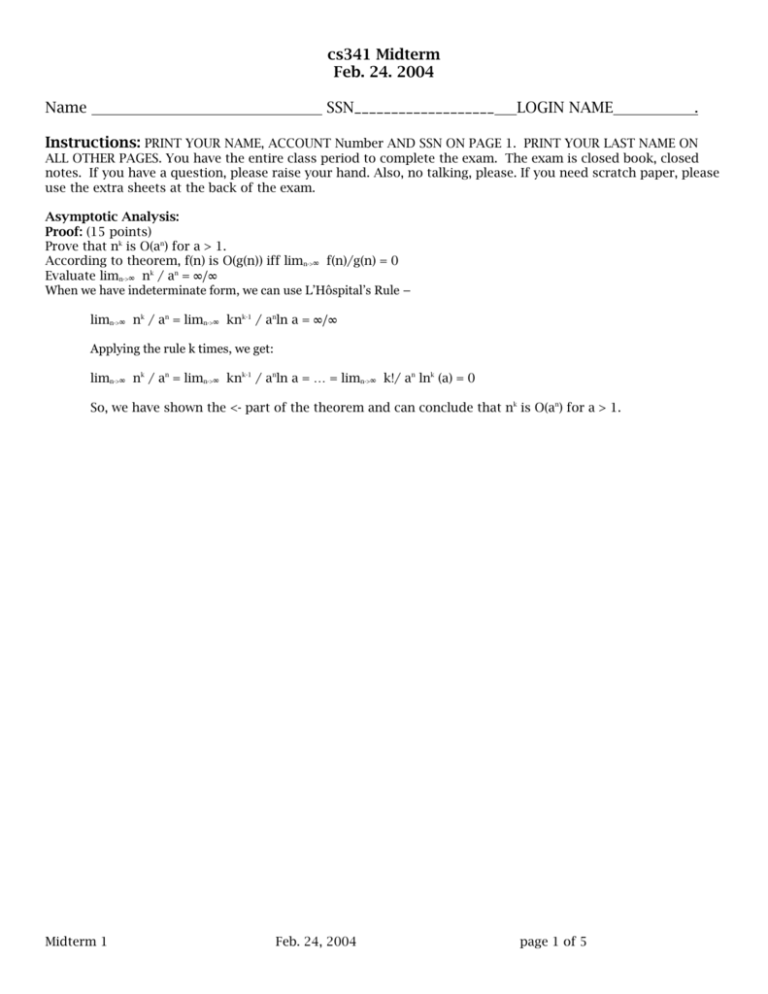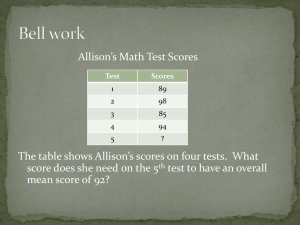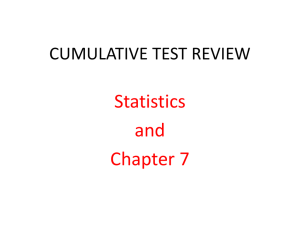here
advertisement

cs341 Midterm
Feb. 24. 2004
Name
SSN___________________
LOGIN NAME
.
Instructions: PRINT YOUR NAME, ACCOUNT Number AND SSN ON PAGE 1. PRINT YOUR LAST NAME ON
ALL OTHER PAGES. You have the entire class period to complete the exam. The exam is closed book, closed
notes. If you have a question, please raise your hand. Also, no talking, please. If you need scratch paper, please
use the extra sheets at the back of the exam.
Asymptotic Analysis:
Proof: (15 points)
Prove that nk is O(an) for a > 1.
According to theorem, f(n) is O(g(n)) iff limn->∞ f(n)/g(n) = 0
Evaluate limn->∞ nk / an = ∞/∞
When we have indeterminate form, we can use L’Hôspital’s Rule –
limn->∞ nk / an = limn->∞ knk-1 / anln a = ∞/∞
Applying the rule k times, we get:
limn->∞ nk / an = limn->∞ knk-1 / anln a = … = limn->∞ k!/ an lnk (a) = 0
So, we have shown the <- part of the theorem and can conclude that nk is O(an) for a > 1.
Midterm 1
Feb. 24, 2004
page 1 of 5
Last Name_____________________________________________
Code evaluation: what is the run time efficiency (big O) for each of these code snippets? Please note: there is
no partial credit for wrong answers. Each problem is worth 5 points.
a) int fun1(int m, n){
//m>n>0;
while (m>=0)
m-=n;
return (m);
}
(note: both m and n are variables)
Your answer :
fun1 is O(m/n) The thing to note is that the
run time changes as a function of
both m and n.
b) int sum =0;
Your answer:
for(int z = 1; z < n; ++z)
for (int i = 1; i *i <=n; i++)
the fragment is O ( n3/2) or O(n √n) : inner loop
sum++;
executes sqrt(n) times for each iteration of outer loop
c) int sum=0;
for (int z=1; z < n; z*=2)
for(int w = 0; w < z; w++)
sum++;
midterm 1
Your answer:
The fragment is O( n ) WE DID THIS ONE IN CLASS!!!
Feb. 24, 2004
page 2 of 5
Last Name_____________________________________________
Lists, Stacks, Queues, Deques
You may use only the public methods included in the class definitions for list, stack, and queue classes (they’re
at the back of the exam): Note that you are NOT writing member functions, which means you must use iterators
to access and navigate through lists.
(20 points) Write the non-member function "JoinList" It has the function prototype
list<Object> JoinList( const List<Object> &L1, const List <Object> &L2)
Join takes its 2 parameters and returns a new list that consists of all of the elements in L1 followed by
all of the elements in L2 that are not already in L1. For example, if L1 were <5, 3, 5, 8> and L2 were <1, 3, 4, 9>
then append would return the list <5, 3, 5, 8, 1, 4, 9>
Part 2: (5 points) If lists are implemented as a singly linked lists, what is the average-case big – Oh asymptotic
time performance of your code ? Prove your answer.
list<Object> JoinList( const List<Object> &L1, const List <Object> &L2) {
List <Object> result;
ListItr<Object> itr1=L1.first();
ListItr<Object> ritr = result.zeroth(); //always the insertion point
//copy L1 into result, keeping ritr the insertion point
// this is why we don’t just use copy constructor or = operator.
while (! itr1.isPastEnd()){
result.insert(itr1.retrieve(), ritr);
itr1.advance();
ritr.advance():
}
//next, copy non-duplicated elements of L2 into result
ListItr <Object> itr2=L2.first();
while (! itr2.isPastEnd()){
Object Z = itr2.retrieve();
if (! (L1.find(Z).isPastEnd()) ) {
result.insert(Z, ritr);
ritr.advance():
}
itr2.advance():
}
return result;
}
Part 2: first while loop is O(|L1|)
second while loop is O(|L1| * |L2|) because for each item in L2 (O(|L2|)
we perform find in L1, which is O(|L1|). By product rule, time is
O(|L1| * |L2|) .
By sum rule, T(first while) + T(second while) = max( O(first while), O(second while) ),
which for lists of size > 1 O(|L1| * |L2|)
midterm 1
Feb. 24, 2004
page 3 of 5
Last Name_____________________________________________
Lists, Stacks, Queues, Deques (continued)
(20 points) Write a non-member function named “median”. Median takes as its single argument a sorted list
and returns an iterator that references the median element. If a list is of size n, then the median element is in
position (n+1)/2 For instance, if the list were <1, 2, 4, 900, 999> the median element is 4 (# elements = 5, and
(5+1)/2 =3rd position ) Your function should return an iterator that refers to it. You should be able to do this
in 1 pass through the list.
The function has this prototype: ListIterator<Comparable> median(const List<Comparable> & L)
ListIterator<Comparable> median(const List<Comparable> & L) {
ListItr <Comparable> scan = L.first();
ListItr <Comparable mdn = L.zeroth();
//handle special case first:
if (L.isEmpty()) return scan;
// loop invariant: mdn is always pointing to median of elements that have already
// been scanned; scan points to last element scanned.
while (! scan.isPastEnd()) {
mdn.advance();
scan.advance();
if (!scan.isPastEnd())
scan.advance();
}
return mdn;
}
Note: if you counted number of elements (scan 1) and then rescanned to get to median, you did not lose
points, because the number of calls to advance() is the same as shown here. If you assumed the existence of a
sizeof() for the list, or if you made an auxiliary structure (vector, etc.) or used findprevious, you lost some
points because those methods were either grossly inefficient or incorrect.
midterm 1
Feb. 24, 2004
page 4 of 5
Last Name_____________________________________________
Short Answers:
(15 points)Give an example of using aggregation (has-a relationship). Give an example of an adapter pattern.
What is the difference between aggregation and the adapter pattern?
(many possible examples)
Key points:
Aggregation uses an instance of a class as a data member of another class; the user of the composite may or
may not be able to manipulate the aggregate member; example: an instance of a Queue class may be included
as a data member in an ComputerOperatingSystem class.
Adapter pattern redefines the interface to a class, adding no new functionality to the adapted class. Examples
– the stack class exposes push, pop member functions, which are written as clients of a deque class. Some of
you used the terminology “wrapper” class, which while not completely accurate, was close enough.
midterm 1
Feb. 24, 2004
page 5 of 5







